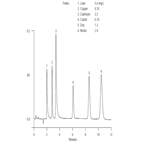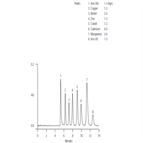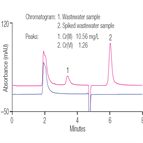Find methods for your needs
Refine by Feature
Displaying 1-5 of 6 results for Tag: metal
TN10: Determination of Transition Metals by Ion Chromatography Using Oxalate Buffer Eluent
Instrument Type: ICThe IonPac CS5A column has both cation and anion exchange capacity, allowing metals to be separated as cations or anions on a single column. This is called a mixed mode separation.Transition metals are separated as both cationic and anionic complexes with the oxalate chelating agent added to the eluent.The metals are detected by measuring the absorbance at 530 nm of the complex formed with the postcolumn PAR reagent.
TN10: Determination of Transition Metals by Ion Chromatography Using PDCA Eluent
Instrument Type: ICThe IonPac CS5A column has both cation and anion exchange capacity, allowing metals to be separated as cations or anions on a single column. This is called a mixed mode separation.Transition metals are separated as anionic complexes with the PDCA chelating agent added to the eluent. The metals are detected by measuring the absorbance at 530 nm of the complex formed with the postcolumn PAR reagent.
AU165: Separation of Chromium (III) and Chromium (VI) by Ion Chromatography
Instrument Type: ICThis application update demonstrates separation and detection of Cr(III) and Cr(VI) using a Dionex IonPac CS5A column and absorbance detection. This method also describes a sample preparation technique that can be used to estimate the concentrations of Cr(III) and Cr(VI) in soil and wastewater samples.
AN43098: Speciation analysis of Cr (III) and Cr (VI) in drinking waters using anion exchange chromatography coupled to ICP-MS
Instrument Type: ICSpeciation determinations of ionic compounds are important to determine the concentration of the more toxic form in the total elemental composition. Chromium is an industrial waste contaminant that can have serious health effects and therefore requires monitoring in municipal water systems. This method determines Chromium VI and Chromium III species in a municipal drinking water sample. The ions are separated by ion chromatography (IC) on an IonPac AG7 guard column and detected by Inductively Coupled Plasma Mass Spectrometry (ICP-MS) at ng/g. This method is further optimized in AN43175.
AN43175: The Migration of Elements from Toys and Speciation of Chromium (VI) in Toy Material Using a IC-ICP-MS Solution
Instrument Type: ICSpeciation determinations of ionic compounds are important to determine the concentration of the more toxic form in the total elemental composition. Chromium compounds have brilliant hues and consequently are often used in dyes and inks however, chromium compounds are toxic. Chromium VI species is very toxic so it is monitored as an extractable in children’s toys. This method determines extractable Chromium VI (SOP EN 71-3:2012) in an ink sample separated by ion chromatography (IC) on IonPac AG7 guard column and detected by Inductively Coupled Plasma Mass Spectrometry (ICP-MS) at ng/L.





